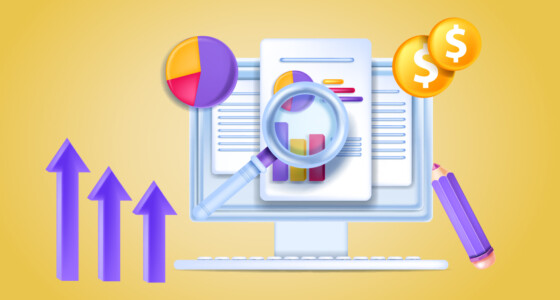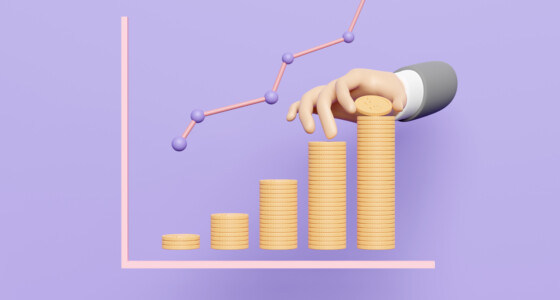

Stocks tend to get a lot more attention than bonds, but did you know the global bond market is much more prominent in market capitalization than the equity market? Read on to find out how bonds differ from stocks and what the value of an investment is.
What is a bond?
A bond is a fixed-income investment security that represents a loan paid by an investor to a borrower (usually a company or government department) in exchange for regular interest payments. In simpler words, a bond can be considered an I.O.U. between the borrower and the lender.
The details of the bond are also declared before it is purchased. They include the end date (when the initial amount of the loan is due to be paid back to the bond owner) and the terms for the variable or fixed interest payments agreed to by the borrower.
Bonds are sold by all sorts of companies, municipalities, governments, and states with the intent of financing ongoing operations, developmental projects, or acquisitions. But what is the meaning of a bond for the average person who bought it? Investing in a bond makes you a debtholder for the entity that issued it.
Who issues bonds?
As debt instruments, bonds represent loans paid to the issuer. All levels of government and corporations use bonds to borrow and generate funds. Governments use them to supplement taxes and fund roads, schools, and other infrastructure. Unexpected expenses such as war can also suddenly demand the need to raise significant funds.
Similarly, businesses and corporations often borrow money via bonds to expand business operations by purchasing equipment and property, building profitable projects, research, and development, or hiring new teams and employees. Because of the scale of their operations, large organizations often require more money than an average bank can provide them, and bonds help solve this problem.
Bonds are used as a solution allowing several individual investors to pick up the role of the lender. With thousands of investors in the public debt market, each lends a small portion of the capital needed, distributing the risk and helping organizations generate the money they need. Moreover, lenders can also sell their bonds in the market to other investors long after they were initially issued, making them quite a safe investment.
Characteristics of bonds
Some basic characteristics are used to define investment bonds.
Face value
It is also called the par value. It is the amount that will be paid out at maturity. Face value is also used as a reference amount used to calculate interest payments. Whether the investor purchases the bond at a premium of $1,090 or when it trades at a discount for $980, both investors will get the same $1,000 face value of the bond when it matures.
Coupon rate
It is the rate of interest that the bond issuer pays the lender. The coupon rate is expressed as a percentage of the face value of the bond. Such as, a 5% coupon rate means the bondholders can expect to receive 5% of a $1,000 face value, which equates to $50 every year.
The dates at which the bond issuer promises to make interest payments are called coupon dates. They can be with any fixed interval, but the industry standard is semiannual payments.
Maturity date and Issue price
The maturity date is the day on which the bond will ‘mature,’ and the bondholder will be paid out the face value of the bond by the issuer.
The issue price is the original price at which the bond issuer sells the bonds. In most cases, this is equal to face value, but this is not necessary.
Credit quality and time to maturity — are the two features of bonds that act as the principal determinants of any bond’s coupon rate. An issuer with a poor credit rating has a higher risk of default, so their bonds pay a higher interest.
In the same manner, bonds with very long maturity dates also typically pay a higher interest rate because the lender is more exposed to the general interest rate and inflation risks for an extended period.
Credit ratings for most companies and their bonds are generated and released by credit rating agencies such as Moody’s, Standard and Poor’s, and Fitch Ratings. The highest quality bonds are labeled as “investment grade” bonds and include those issued by stable companies, such as utility companies, and entities, such as the U.S. government.
Bonds not considered investment grade but also not in default are categorized as “high yield” or “junk” bonds. These bonds hold a higher default risk in the future, and so investors expect a higher coupon rate to compensate for that risk.
As interest rates change, bonds and bond portfolios can see a rise or fall in value. “Duration” is the term used to describe the bond’s sensitivity to changes in the interest rate environment. Using the term duration in this context can confuse fresh bond investors because the word isn’t used literally here to refer to the length of time required for the bond to mature. Instead, it describes how much a change in interest rates can cause a bond’s price to rise or fall.
Yet another term, “convexity,” is used to describe the rate of change in duration (a bond’s or bond portfolio’s sensitivity to interest rates). These factors are quite complicated to calculate, and professionals usually carry out the required analysis.

How do bonds work?
Bonds are fixed-income securities and account for a good majority of individual investors’ portfolios because they are low-risk investments. They can help cover the risk associated with volatile investments like stocks and provide a reliable income stream during someone’s retirement years while preserving capital.
Consider how bonds work in the financial market:
- Companies and other entities identify the need to raise money for new projects, maintain ongoing operations, or pay back existing debts.
- They then issue bonds to investors. The issuer is the borrower and declares the terms of the bond, the interest payments that will be made, and the maturity date (the due date at which the bond principal will be paid back).
- The selling price per individual bond is usually set at face value. However, the actual market price of the bond depends on different factors (such as the issuer’s creditworthiness).
- The bondholder earns interest payments from the date of issuance to the date of maturity for loaning their money to the issuer. The interest rates used to calculate the payments are also called coupon rates.
- The initial bondholder can sell most bonds in the open market to other investors once they have been issued. As such, a bond investor is not obliged to hold a bond to its maturity date.
Once the bond matures, the bondholder is paid the face value of the bond, no matter what price they purchased it for.
Why purchase bonds?
To do this, you need to understand what bonds are and their value in the stock market.
Advantages:
- Effortless and predictable income stream via interest payments.
- No loss of principal if the bond is held till maturity.
- Potential profit can be expected if there is a fluctuation in market prices.
- Can offset exposure to volatile stock holdings.
Disadvantages:
- Generally, bonds pay out lower returns than stocks.
- There’s a risk of companies defaulting on your bonds.
- Bond yields have the potential to fall.
If the pros outweigh the cons for you, then, of course, you should have bonds in your portfolio.
Different types of bonds
There are four basic categories of bonds seen in the financial market.
Corporate bonds
They are bonds issued by private and public corporations. Companies do this as an alternative to seeking bank financing loans because, in many cases, bond markets provide better terms and lower interest rates.
Municipal bonds
They are also called Munis, issued by government entities, states, cities, and counties. Interest earned on these bonds is usually tax-free at the federal and state level, making them an excellent investment for high-net-worth investors and those looking for a tax-free income source after retirement.
Types of these bonds include:
- General obligation bonds. Not secured by any asset, these bonds are backed by the issuer’s “full faith and credit”, which has the authority to tax residents to pay their debt to bondholders.
- Revenue bonds. These bonds are backed by revenues sourced from a specific project or source, such as lease fees or highway tolls, instead of taxes. Some revenue bonds have the drawback of being “non-recourse”. If the revenue stream ends, the bondholders cannot claim the underlying revenue source.
- Conduit bonds. Sometimes governments issue municipal bonds on behalf of private organizations such as non-profit hospitals or colleges. These borrowers agree to repay the issuer, responsible for paying the interest and principal on the bonds. If the conduit borrower fails to make a payment, the issuer is not required to clear the debt with the bondholders.
Government bonds
Bonds issued by the U.S. Treasury fall into this category. Those issued with a period of a year or less to maturity are called Bills. Bonds issued with maturity periods of one to 10 years are called Notes; bonds with more than 10 years to maturity are issued as Bonds. All these bonds issued by the government treasury are often referred to as Treasuries.
Agency bonds
They are bonds issued by government-affiliated entities such as Fannie Mae or Freddie Mac.
Varieties of bonds
There are wide different varieties of bonds available to investors. They can be categorized by different attributes such as the rate or type of interest, by being issuer-recalled, or other special properties.
Zero-coupon bonds
Z-bonds or Zero-coupon bonds do not pay bondholders any coupon payments but are issued at a lower price than their par value, helping the holders generate a return once they are paid off the total face value of the bond when it matures. An excellent example of these is the U.S. Treasury bills.
Convertible bonds
Essentially, bondholders can convert corporate bonds into shares of the issuing company before maturity.
They have an embedded option that lets bondholders convert their debt into equity at some point before maturity, with certain conditions such as share price. These bonds can be the best solution for a company because they could pay lower interest payments while the project is in its early stages. If the investors were to convert their bonds, the other shares would get diluted, but no more interest or principal would have to be paid out by the company to bondholders.
Let’s go through an example. Imagine a company looking to borrow a million dollars to fund a new project. They would have two options: they could generate funds by issuing bonds with a 12% coupon rate that mature in 15 years, or they could sell investors bonds with an 8% coupon rate with the option for them to convert the bond into stock if the stock’s price were to rise above a certain value. For companies short on initial funds, this can be a very lucrative path to go down.
On the other hand, investors who purchased the convertible bond also benefit as they can profit from the rise in the stock if the project successfully progresses as planned. By risking more by taking on a lower coupon payment, they can potentially profit big if the bonds are converted to stock.
Callable bonds
The issuing company can call back a callable bond before its maturity. Let’s say a company has issued bonds borrowing $1 million with an 11% coupon to mature in 10 years. Suppose general interest rates decline in year six, and the company now finds it can borrow for a 9% coupon. In that case, it can call or buy back the bonds from the bondholders for the principal and reissue new bonds with a lower coupon rate.
With this clause in its terms, callable bonds are less profitable for the bond buyer. Remember, as interest rates fall, bond prices tend to rise. Since callable bonds are likely to be called when they increase in value, they are not as valuable as other bonds with similar coupon rates, maturity, and credit rating.
Puttable bonds
A puttable bond is a kind of bond that lets bondholders put (sell) the bond back to the issuing company before its maturation. Investors value this characteristic because if the bond’s value falls or interest rates rise, they can get their principal back before it falls in value.
Bond issuers sell puttable bonds to benefit the bondholders, and in return, they get to offer a lower coupon rate and boost the number of bonds they successfully sell. A puttable bond typically trades for a higher value than a similar bond with the same maturity period, credit rating, and coupon rate but without a put option.
There isn’t a policy or standard governing each of these rights, and some bonds might contain more than just one option. The number of variations, including embedded puts, convertibility rights, and call options, means there are endless unique combinations that can then be found in bonds. It makes comparison difficult but also means there is something to meet everyone’s investing demands. Individual investors usually rely on bond professionals to meet their investing goals.
How are bonds priced?
Bonds are initially priced based on their face value or par. Bonds priced above face value (higher than par) are said to be trading at a premium. On the other hand, bonds priced below their face value (below par) are said to trade at a discount.
Like other publicly traded securities, supply and demand play a key role in determining the observed price at any given moment. A bond’s price can thus change on a day-to-day basis based on the market environment and its characteristics. Factors that play a role include credit rating, market interest rates, maturity periods, variations, etc.
As discussed above, a highly-rated, investment-grade bond will pay a smaller coupon rate (a lower interest rate) than a low-rated, below-investment-grade bond. The smaller coupon relates to the bond’s lower yield, meaning lower returns for investors. But if demand for such a highly rated bond falls suddenly, its market price would also fall, causing it to trade at a discount to par. However, its earning rate would increase, as buyers could earn a higher percentage of the lower purchase price because of the fixed coupon rate.
Market interest rates add to the pricing complexity. Corporate and government bonds have different characteristics.
For example, let’s say that prevailing interest rates are 10% when a short-term $1,000 government bond is issued. A similar corporate bond with similar interest rates, maturity date, and face value is also issued. The average investor would be indifferent to purchasing either the government or the corporate bond since both would produce a yield of $100. But a little while later, the economy went down, and interest rates dropped to 5%. In such a case, the investor can now only get $50 from the government bond they purchased but would still get $100 from the interest rates of the corporate bond.
This key difference makes corporate bonds much more attractive to investors. The market will bid up the price of the bond until it trades at a premium to counter loss from the prevailing interest rate — in this case, the corporate bond will end up trading at $2,000 so that the $100 interest payouts represent a 5% yield. Similarly, if interest rates rose to 15%, investors could make $150 from government bonds and would not feel the need to pay $1,000 to earn $100. The corporate bond would now be sold at a discount until the loss in yields is compensated for. In this case, its price would settle at $666.67.
Bond prices and Interest rates
A bond’s price fluctuates inversely to interest rates: as general interest rates rise, yields from freshly issued bonds increase as well, depressing the prices of old bonds with a lower coupon rate.
A sample bond issued by a company with a face value of $10,000 may carry a 5% coupon. A rise in interest rates a year later allows the same company to issue new bonds with a 5.5% coupon to keep up with market rates and attract more investors. It would cause a decrease in demand for the bonds with a 5% coupon as the new bond pays 5.5% and would be preferred by investors.
To sell the first bond to investors (using the $10,000 bond example), the old bond would trade at a discount, let’s say $9,000. Investors would purchase the 5% bond to get a discount on their purchase price, which would effectively make the old bond’s yield rate similar to that of the new 5.5% bond.
Yield-to-Maturity (YTM)
Another key number professional investors consider for working out a bond’s price is its yield-to-maturity (YTM). YTM is used to convey the total return bondholders can expect on a bond, given it is held until the end of its lifetime. It is expressed as an annual rate and is the internal rate of return of the investment in a bond if the investor were to hold the bond until maturity and receive all payments as scheduled.
Though calculating and understanding the YTM is complex, it is quite helpful as a stat for evaluating and comparing bonds with each other. It considers different coupons and maturity dates of bonds in the market. The formula for calculating the YTM involves equating and solving for the interest rate; it is not easy and is mainly done using computer software.
YTM = nface valuepresent value-1
Another important measure is the expected changes in bond prices for a given change in interest rates, which is known as the duration of a bond. Since this originally referred to zero-coupon bonds, whose duration is equal to its maturity, it is expressed as units of the number of years.
However, for practical purposes, the duration depicts the expected change in the price of a bond with a 1% change in interest rates. This more pragmatic definition is also called the modified duration of a bond.
The duration is also used to determine a bond’s or bond portfolio’s price sensitivity to changes in interest rates. Generally, bonds with long maturities and low coupons are the most sensitive to interest rate changes. However, it is important to understand that a bond’s duration is not a linear risk measure. As rates and prices change, the duration also changes, and convexity is the measure of this relationship.
Bond example
A bond is a promise by a borrower to a lender to pay back their principal, usually along with interest. Governments, municipalities, and corporations can issue them.
The coupon rate, principal amount, and period to maturity are pre decided and are set by the issuer to meet their goals. Most bonds come with extra options that can increase or decrease their value and risk, making comparisons quite tricky for non-professionals. However, anyone can buy bonds, sell them before they mature, and they are often publicly listed and can be traded through a broker.
Prevailing interest rates play a significant role in bond values as fixed-rate coupon bonds pay the same rate on their face value over time. Any market interest rate will cause fluctuations in the bond’s importance as the yield becomes more or less attractive to investors.
Let’s assume a bond that was issued with a par value of $10,000 par value and a coupon rate of 6%. The bondholder will be paid $600 as interest income annually (most bond interest is split and paid semi-annually). Theoretically, if nothing else were to change in the interest rate environment, the bond price would remain at its par value.
However, this is rarely the case in the real world. The good thing is that no matter what happens in the markets, the issuer still pays the total face value to the lender once the bond matures.
Bonds FAQs
So, we have considered the main points of what bonds are, how they work, and their value as an investment in the financial market. However, let’s delve into a number of frequently asked questions by investors.
What is an example of a bond?
Imagine the case of ABC Corporation. The company wishes to collect $5 million to finance the development of a new facility but cannot get a bank to finance them. Bonds are then used instead to raise the funds of $5 million. The terms of the bond state that ABC promises to pay its lenders a 5% interest per year over five years, with interest to be paid semi-annually. With the face value of each bond being $1,000, ABC has to sell a total of 5,000 bonds to reach its target.
Are bonds a good investment?
Diversifying your investment portfolio with some amount of bonds is typically recommended as they are less volatile than stocks. If bonds are allowed to mature, they will reliably return the entire principal at the end, along with some interest payments made along the way. Their low risk means that bonds are suitable for investors looking for a passive income and wanting to preserve their capital. It is why they are ideal investments for older individuals approaching retirement.
How do I buy bonds?
In the past, there used to be only several specialized bond brokers. However, today anyone can access the bond market via online and discount brokers, and anyone can buy and sell them similar to how you would with stocks. You can also add bonds to your portfolio indirectly by investing in fixed-income ETFs or mutual funds that hold a portion of their portfolio in bonds. Some special bonds, such as treasury bonds and TIPS, are mostly sold directly via the federal government’s TreasuryDirect website.
The bottom line
Whether you work with a financial expert or self-manage your investments, fixed-income investments such as bonds should be a significant asset of your investing strategy, as bonds can provide stability and predictable income to a well-diversified investment portfolio.









